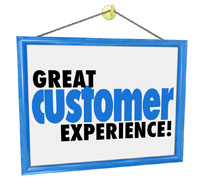Kristina Evey examines some of the difficulties faced when providing excellent service—and how to overcome them.
 An excellent customer service experience is something that all customers want, yet most businesses fail to deliver one.
An excellent customer service experience is something that all customers want, yet most businesses fail to deliver one.
Some studies suggest that customers will knowingly pay more for a product or service that is not state of the art, or not the highest known quality, simply because the experience they receive from that vendor is second to none.
So, with customers craving and willing to pay more for superior service and experiences, why in the world aren’t more businesses delivering them?
Here are three reasons why and what to do about it:
1. You didn’t hire right. 90% of the service experience lies in the hands of the folks we hire onto our teams. If you make a bad hiring decision, you’ve just guaranteed that you will be driving many of your customers to your competition.
What can you do about it? Hire the smile, then train the skill. When you hire folks that are customer centric, friendly, an enthusiastic about your company, then you’ve won the major battle of being ahead of your competition in service. Identify the characteristics of your most customer centered team members and list those as “must haves” for the next candidate you hire.
2. You didn’t instill your customer centric culture to all levels of your team. People were most likely hired in, given some general information about how the company operates and what the products or services do for their customers, and sent on their way to do the best they can. If the ideal culture isn’t created and ingrained into everyone, each person in your team will be operating by their own set of standards. This will result in inconsistency and frustration for your customers.
What can you do about it? In order for everyone to be like minded and customer centered, you need to be sure to define the ideal customer centered culture that most fits your business model. Think of some of the businesses renowned for their customer service. What is it about that business that brought them into your mind right now? How do you feel when doing business with them? How does their staff treat you that made you think of them? This is the train of thought you need to have when defining your ideal culture. The next step is to share it, practice it, and ingrain it into every nuance of your company. Everyone from the receptionist, to the mail clerk, to the front line staff, to the managers and top leadership all need to know, believe, and exemplify the ideal culture for your customers.
3. You didn’t set minimum service expectations. You are getting some complaints from customers about the service they are receiving from some of your staff. You are a bit puzzled by this since they are friendly enough and they do their job well, but you notice that others are the ones that customers consistently ask for or will wait for in order to avoid other team members. You have one phone representative that is nice enough, but another that you can just tell by the way he speaks with people on the phone that he is someone you wish you could clone.
What to do about it? Sit down with your team and explain what the minimum service expectations are for everyone. Some folks shy away from this thinking that it should be common sense, but we all have different service standards in our own minds. Be specific. Be clear. Set high standards. Emphasize the friendly factor. Give your team clear wording to use in different situations, ie – answering the phone, asking how they may help someone, apologizing for a mistake, etc.
Bottom Line? – You can do everything you need to do to create the customer service experience that customers crave, desire and are willing to pay more for. The great part is that your team would love be part of the success of your company and it’s much easier than you ever thought it would be. You only need to put some thought and planning into it.
About the Author
Kristina Evey is improving the way companies connect with their customers and increase their profits, she is an accomplished speaker and trainer on Customer Satisfaction and Retention.




